Tombos: For today's video, I've prepared an unusual test, the purpose of which is to outsmart the famous GTO guru, known as the "Poker Giraffe". Will I achieve my goal? Let's get a look.
Qin "QY" Yang is an elite Run It Once coach who has trained over 100 students in various poker formats. If you have watched his videos, you know that he has a deep understanding of poker theory. I decided to test that with an advanced test.
Ready to start? This will be the most difficult test of your life!
QY: Let's go!
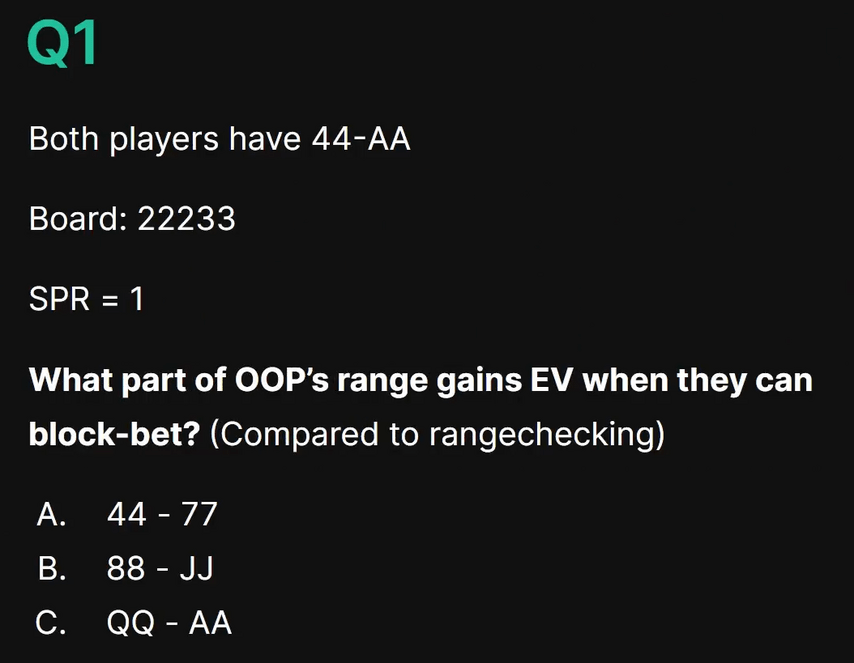
TB: First question. Both players have similar ranges consisting of pairs from to . Board , SPR=1. What part of an out-of-position player's range adds the most to a hand if he can block bet and doesn't have to check his entire range?
QY: Um. Define block bet. Is it a third, a quarter?
TB: Let's keep it simple – let him bet with any size he wants: all-in, 10%, half a pot, third, whatever.
QY: Then I choose "B" – pairs from eights to jacks. This is the final answer.
TB: Okay. Can you elaborate a bit?
QY: Well, it seems to me that for – the right to donk bet is of no particular value. The main idea of a block bet is to get thin value, and for smaller pairs, this is not at all relevant. You need to choose between "B" and "C". It seems to me that for aces and kings, the natural sizing is all-in. And for eights, the ability to block bet allows you to win more than in the case of a check – if you bet a quarter of the pot, you can get called from pairs below fairly regularly. Something like this.
TB: A very logical answer. And the correct answer is "C".
QY: Haha!
TB: Not intuitive, right? Everyone says that the main purpose of donk betting is to increase equity realization from the middle part of the range. And this is absolutely fair. However, if you measure the difference in EV, the biggest win will almost always be at the top of the range.
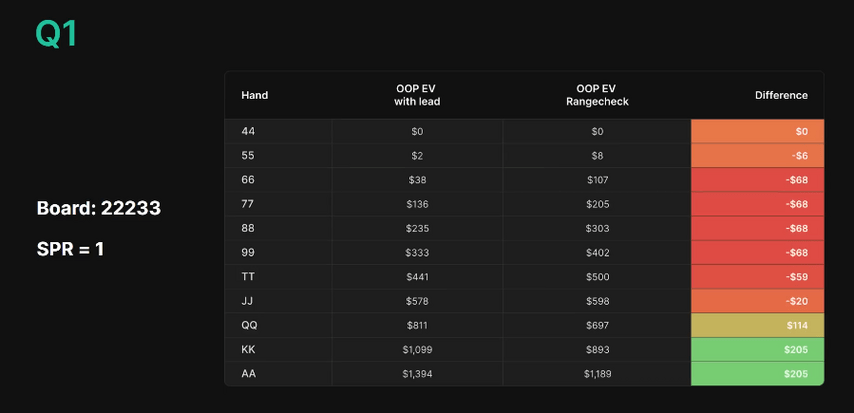
The same is true for higher SPRs, such as SPR=2, and for normal, near-reality ranges.
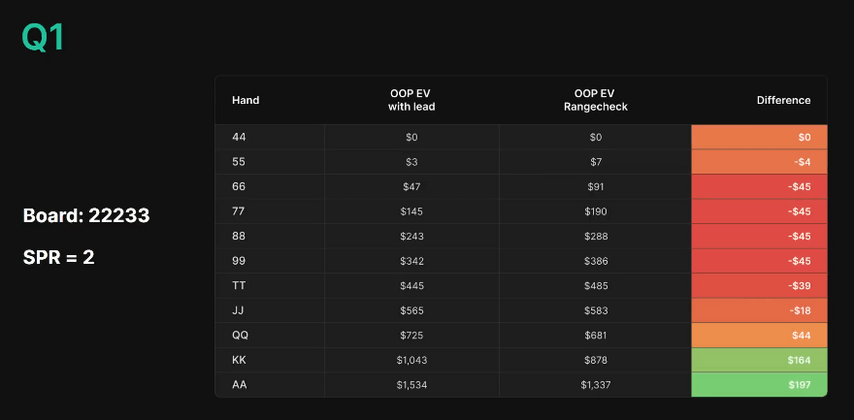
The top of our range is always more profitable to block bet than to check. The clue seems to be that the player in position checks a lot more hands when the player out of position starts by checking his entire range, and this worsens the EV of our nut hands.
QY: Cool.
TB: Here are the solutions to our SPR=1 situation with multiple lead sizes and a range check.
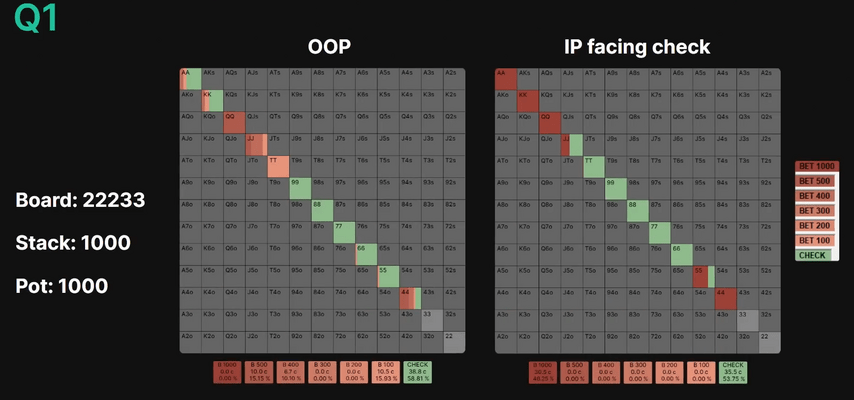
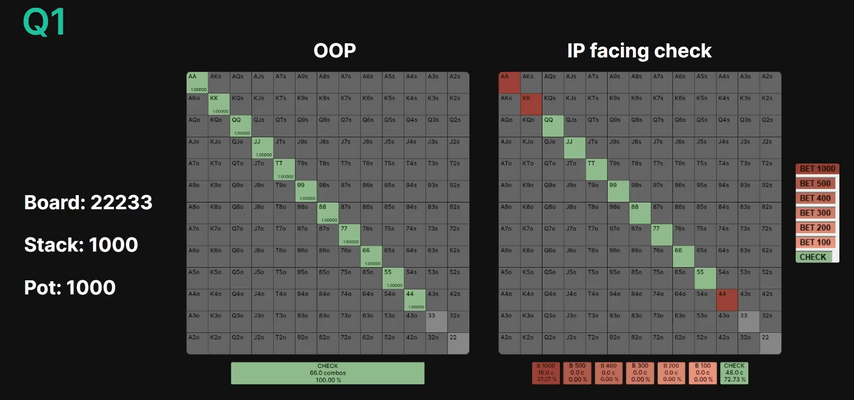
The solver doesn't want to donk shove, but can bet 40%, 50%, and 10% of the pot. For a small bet, a player in position should call fairly widely, including many hands that would check next.
When we have the option to donk bet but choose to check, Villain has to play more aggressively than when we check all hands, and this makes it much more difficult for us to play the middle range.
QY: Yes, I've noticed something similar when analyzing hands: when a player out of position has a block bet on the river, but he checks, the player in position starts to draw much thinner. Indeed, it is logical. Good question.
TB: I like it a lot too.
Next question. Button vs Big Blind, pot raised once. How often should the button check behind on flops where the BB has a donk betting range?
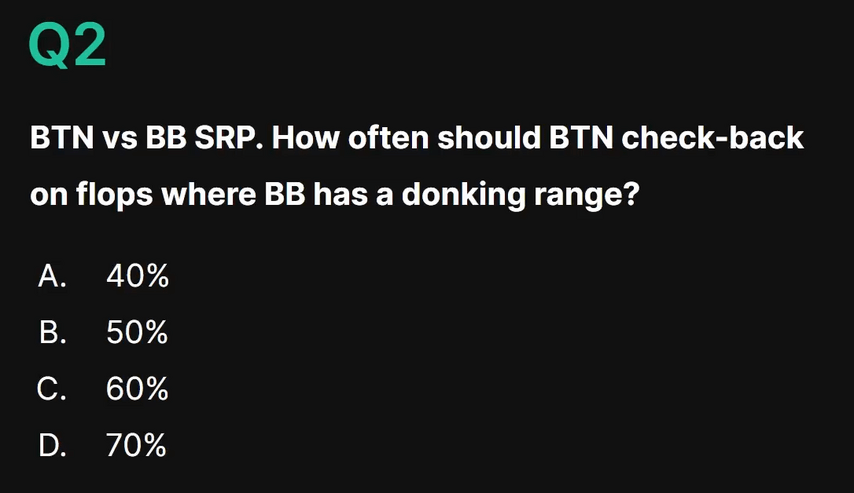
QY: Unfortunately, I think I've already seen this question somewhere. I don't remember whose article it was, maybe even yours! It mentioned the fifty percent rule. The big blind, being out of position, tends to donk bet with such a range that if he checks, the button bets 50% of the time. If the button bets less often, strong hands in the BB's range will suffer too much from checking. So the BB starts adding them to the donk's range until the button has the opportunity to bet half of the range in response to a check.
My answer is "B".
TB: That's the correct answer! And the explanation is correct too.
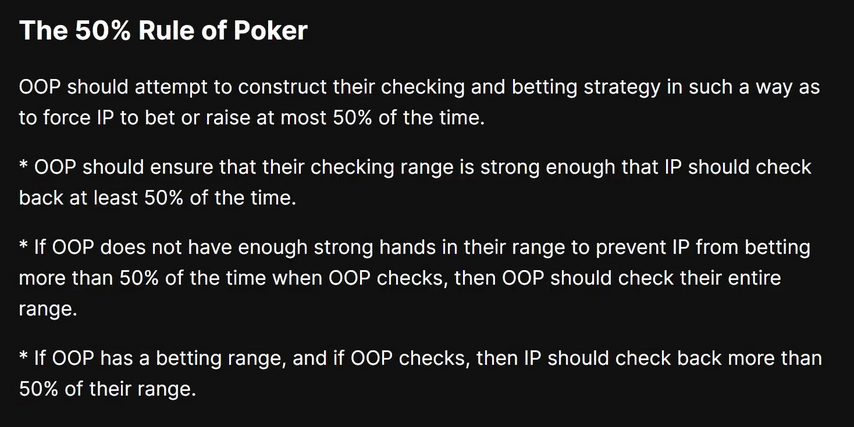
A player out of position should design his check and bet strategy so that a player in position can bet or raise no more than 50% of the time.
A player out of position's checking range must be designed in such a way that a player in position is forced to check behind at least 50% of the time.
If the out of position player doesn't have enough strong hands to prevent his opponent from betting more than 50% when he checks, then he should check his entire range.
If a player out of position has a lead range but checks, his opponent must check more than 50% of his range.
This is more of an observation than a universal law of poker and doesn't work in all cases, but it does quite often.
I can demonstrate it in the example of textures consisting of unpaired and non-paint boards with cards from before .
On all of these boards, the BB can donk bet. He does this with different frequencies:
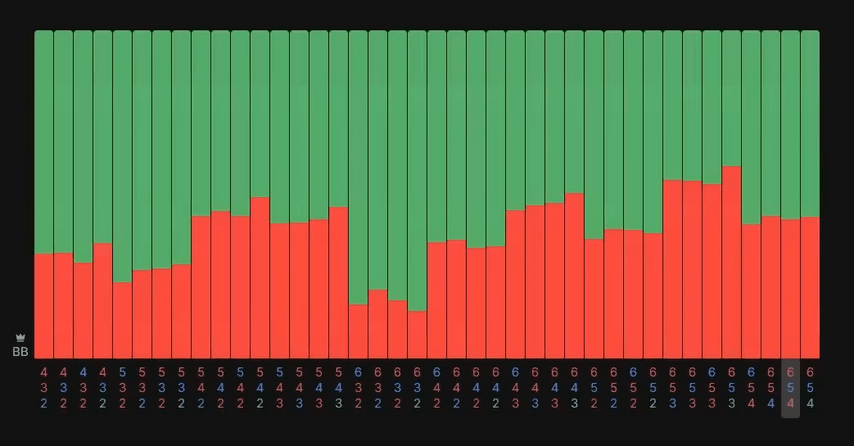
But the button responds to his checks in almost the same way:
QY: Wow! Beautiful.
TB: Let's move on to the next question. I'm sure you'll like it.
Heads-up with deep stacks. On the flop player out of position , the player is in position . The equity is exactly 50/50. The cards of the players are OPEN. Which of them would prefer to put all the money in the pot at once? Maybe both? Or none?
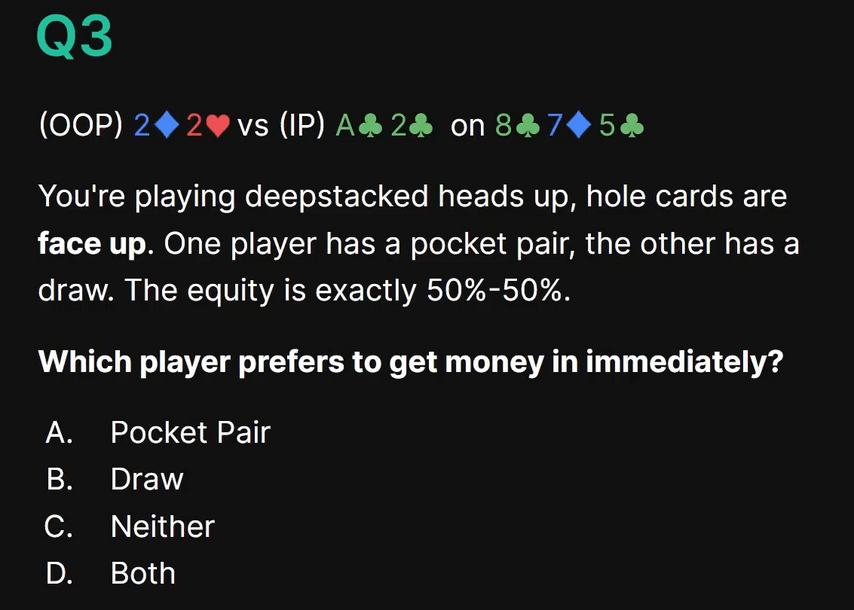
QY: Cool, I love these types of questions! I think that on many of the turns the equity for drops sharply, and should prompt the flush draw holder to bet immediately. We don't want to be in a situation where our opponent will get a big equity advantage on the turn and be able to push us out of the pot by going all in. In my opinion, the equilibrium strategy for the player with – all-in on the flop. It helps to avoid scenarios in which we will not be allowed to realize equity all-in on the turn. So my final answer is B.
TB: Okay. Additional question. If you're the deuces player and you know your opponent checks the flop sometimes, how do you play?
QY: I'm very happy to check so that in the hands he checks next, I shove on good turns for me. This is clearly better than shoving a coin flip on the flop.
TB: Absolutely right. The holder of the draw prefers to bet all-in immediately. This is somewhat contrary to our charts, but open cards change everything. There are no implied pot odds with open cards, no chance to draw, forcing our opponent to make a mistake against our hand. And there are more good turns for a made hand than for draws – 33 cards versus 12.
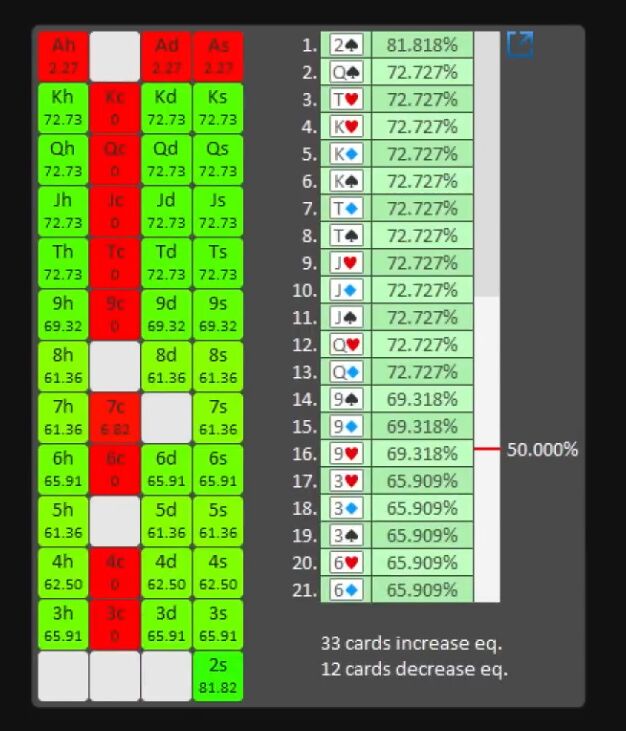
We can say that the equity of a made hand is more stable, while that of a draw is more prone to falling fast.
And, of course, all the cases when the flop is checked-checked are very beneficial for the pocket pair.
Nice question, but it has nothing to do with real poker strategy :)
QY: Yes, more like an IQ test question.
TB: 4th question. Two players, let's call them QY and TV, are playing HU NL50 with rake. QY plays GTO and doesn't adjust. TV is a calling station, so it calls with all the hands it needs to mix calls and folds with but otherwise plays GTO.
How will this change the EV of the players compared to the Nash equilibrium?
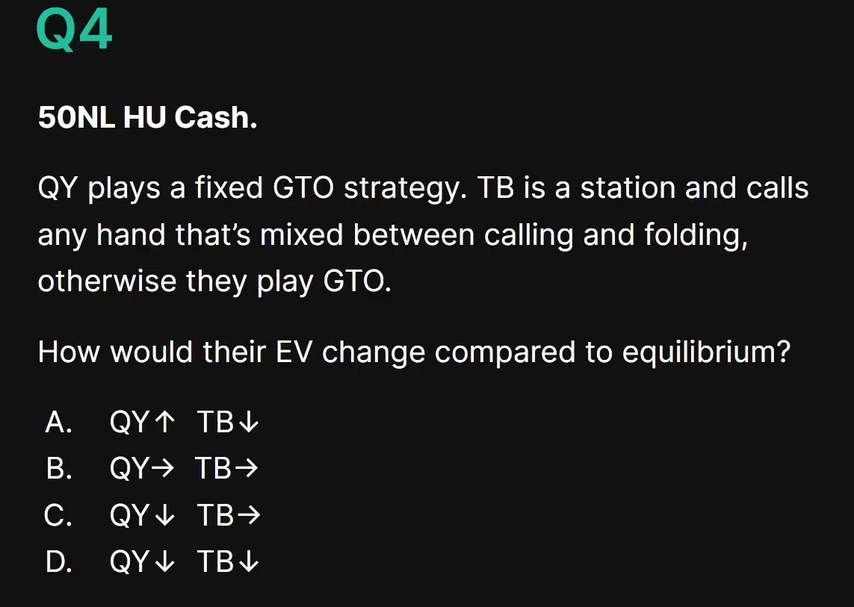
QY: I won't think about this question for too long and I'll choose "D".
TB: Okay. Surprisingly, the correct answer is "C".
QY: What?!
TB: Sounds like total bullshit, doesn't it?
QY: So what am I missing?
TB: Haha! I'll explain now. Of course, this is not very applicable in real life, because stations not only call with zero EV hands to mix with but also make real negative actions.
The answer is explained by the rake. The station calls with more hands, both players show down more often, and the amount of rake paid increases. The GTO player starts to lose EV due to the rake, but the EV of the station stays the same. The station only makes mistakes with the misuse of mixed strategy, moving hands with zero EV from folding to calling, its EV does not change. All excess rake in these hands is paid by the EV of his opponent, who is definitely playing GTO.
It's not fair! But this is a fact, and this is what happens quite often in practice.
QY: Yes, I have seen similar thoughts. The rake is really like the third player in the hand.
TB: There are a lot of situations in 3-max where two players make mistakes and a third GTO suffers because of them. But in a heads-up game, the third player is the rake, whose share can increase when one of the players deviates from the Nash equilibrium.
QY: I realized my mistake: when answering this question, I did not take into account that when calculating the EV of hands that should mix between calling and folding, the rake is already taken into account.
TB: In general, while you can't play against a Nash equilibrium player to increase your EV, theory doesn't stop us from deviating to decrease your opponent's EV. And by calling out of hate with zero bluff catchers, we make the aggressor pay more rake!
5th question. Cutoff vs. BB, single-raised pot. On the river the board is . The flop was checked – c-bet – called, and the turn was checked.
BB Player EV: 6.91. Cutoff Player EV: 2.77
Question: How will EV and BB strategy change if we remove all second pairs ( ) from its range?
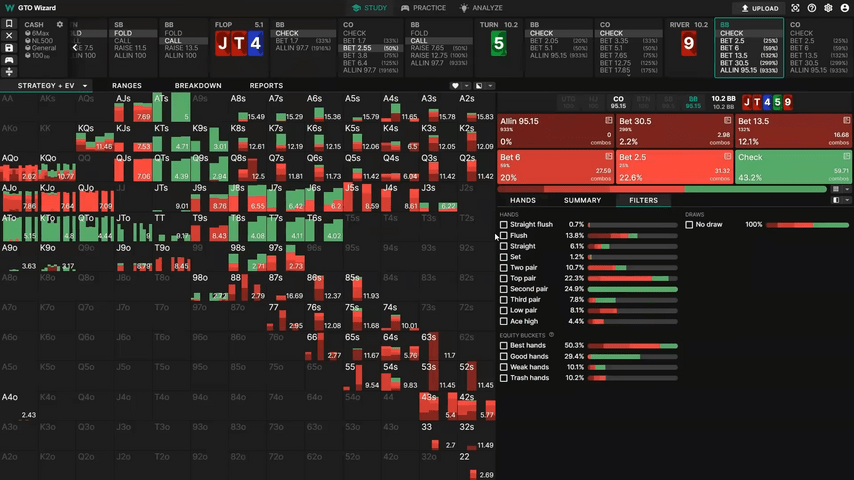 BB strategy for GTO
BB strategy for GTOEquilibrium strategy with all – 100% check. The EV of this check is positive. The BB's total river check percentage is 43.2%. What happens to EV and BB strategy if you remove everything out of his range?
QY: Line is bet – check – bet. The river betting range should be polarized. The second pair is a fairly significant part of our range – almost 25%.
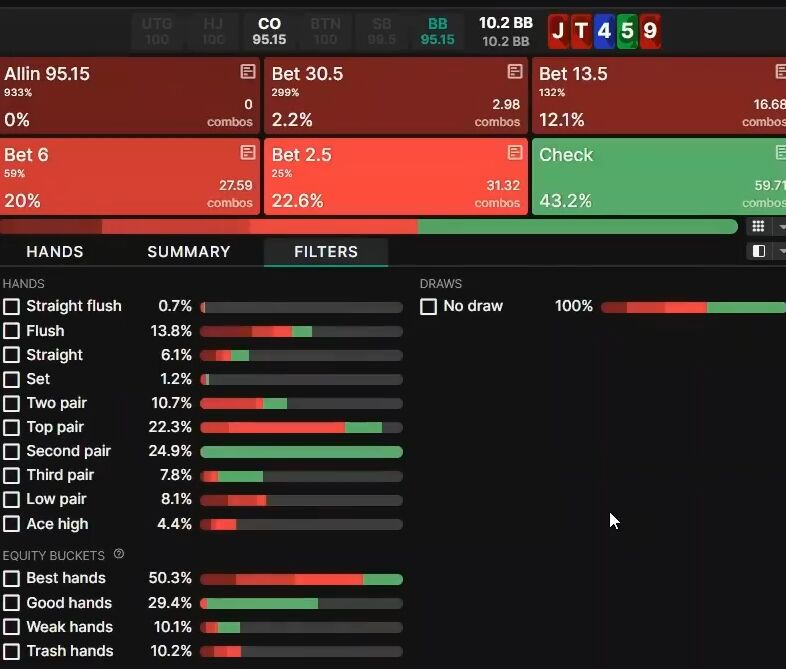
I believe that we will start to play our nut hands much more actively – flushes and straights. Checks will become much smaller because their main goal is to protect their second pair and top pairs with a low kicker.
TB: Okay, but what about EV? With the second pair, it is equal to 6.91.
QY: Should be bigger.
TB: How does the fact that the hands we remove have a positive expectation affect the overall EV?
QY: It certainly doesn't make things worse, because their share of the pot was less than half.
TB: Attention, viewers, we're removing positive EV hands from our range, but our overall EV is going up!
And this is absolutely the correct answer.
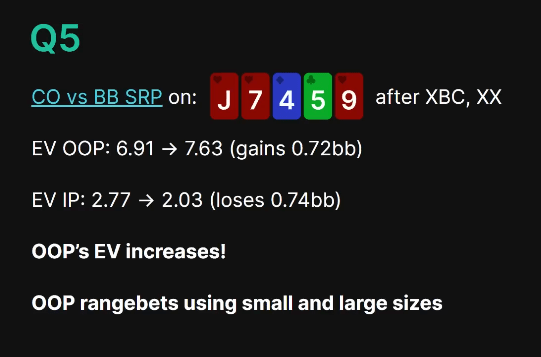
The BB starts betting with almost the entire range and chooses from several sizings, and his expectation rises by 0.72bb.
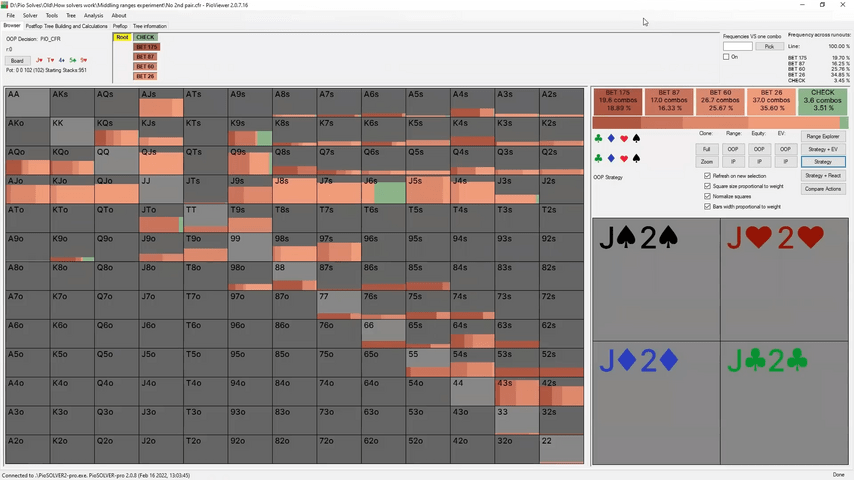
When we remove medium-strength hands from our range that need to be defended, it loosens up our nut hands and allows them to get more aggressive.
Great job!
